Activists Demand Answers At Gowanus Rezoning Open House
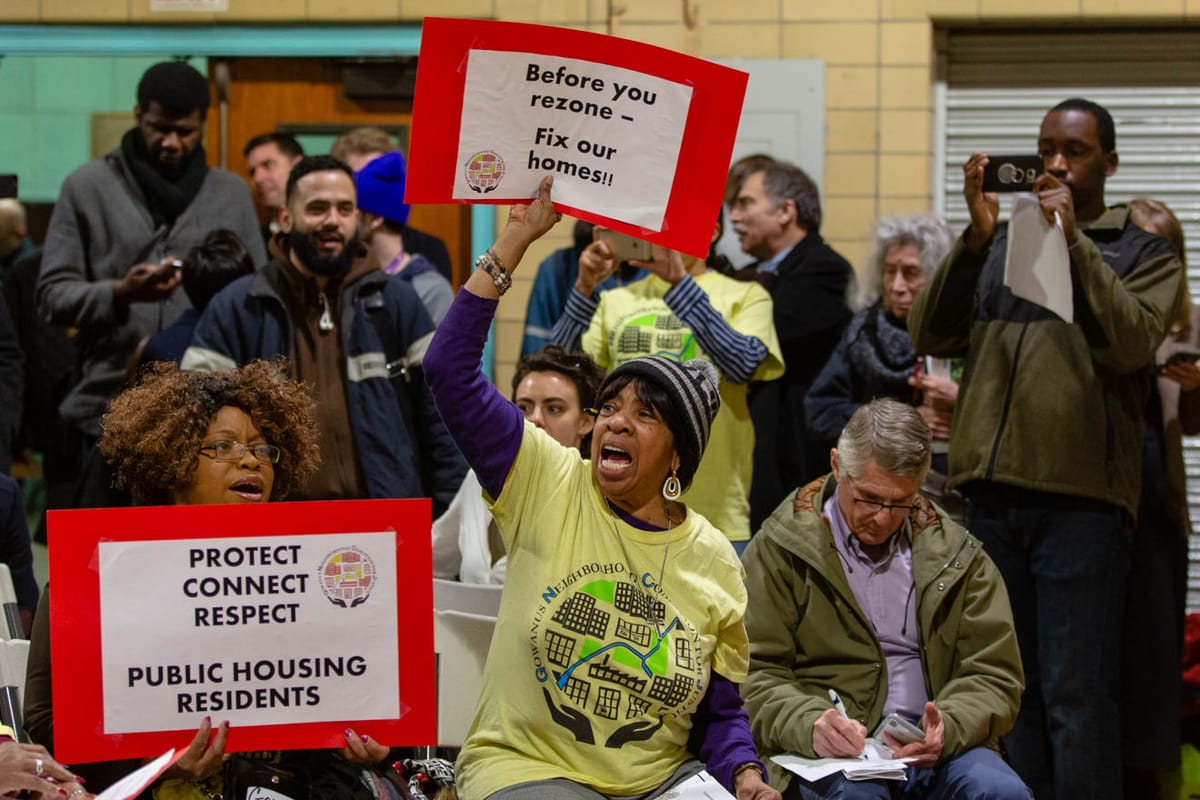
GOWANUS – An activist group hijacked the NYC Department of City Planning‘s (DCP) Gowanus Draft Rezoning Proposal open house Wednesday night, staging their own meeting at the event held inside the packed gymnasium of P.S. 32.

Hundreds showed up last night for DCP’s first community gathering since releasing the Draft Rezoning Proposal last week. Dressed in the organization’s green and yellow t-shirts, the members of the Gowanus Neighborhood Coalition for Justice (GNCJ) came prepared, armed with signs, dozens of folding chairs, and a sound system, setting up their own counter-event in a corner of the gym. The Coalition hoped to convince officials representing various city agencies at the open house to join them in a question-and-answer session addressing their concerns about the draft proposal—particularly its lack of consideration for the three public housing developments in the area.
“Our concerns are about making sure our buildings are fixed—the mold, the lead. We want to make sure our doors are locked at night and not broken,” Cherry Shivers, a GNCJ member and 53-year resident of Wyckoff Gardens, told Bklyner before the meeting.
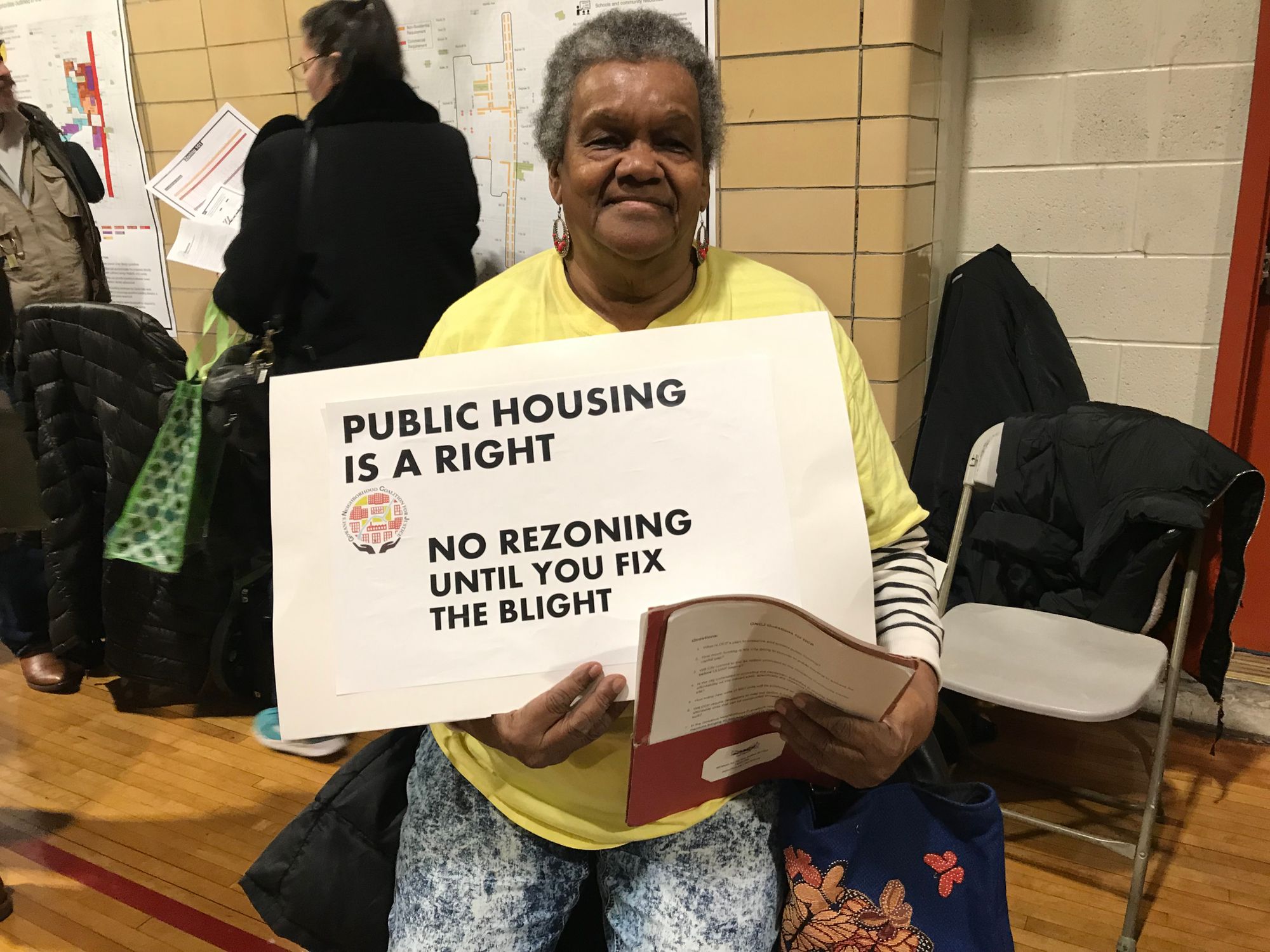
“We love public housing. We like living in public housing. We are angered to the point where we want things done. We want to get answers,” she added.
Using the Gowanus Framework—a document created in 2018 following more than 100 hours of community meetings and workshops—as a “roadmap,” DCP developed the Gowanus Draft Zoning Proposal to “facilitate a vision for Gowanus’ future that is sustainable, resilient and inclusive, with a mix of uses that support new affordable housing and local economic and job growth,” according to a statement by DCP.
“This is a coalition of community people who have been coming to these meetings who want a meeting,” said Karen Blondel, a facilitator for GNCJ, at the start of the group’s hour-long guerrilla gathering. “The Gowanus Neighborhood Coalition for Justice is demanding that the open house format set up for tonight is turned into a real public meeting.”
Launched in 2017, GNCJ is a group of Brooklyn residents, community-based organizations, and small businesses that advocates for low- and moderate-income residents, public housing tenants, and industrial and commercial businesses.
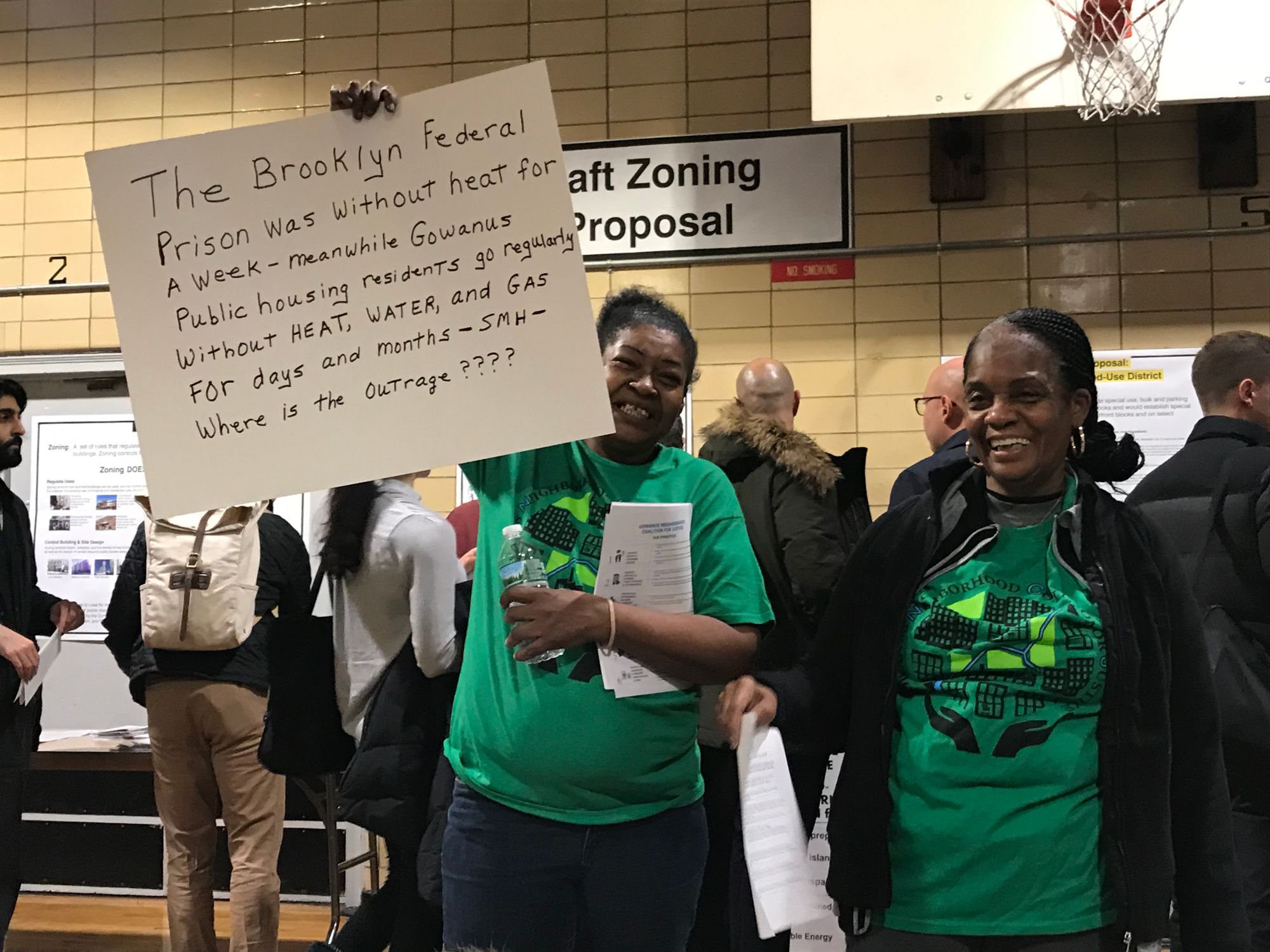
Blondel fielded questions from members of the audience and led chants that demanded city officials to “come take a seat!” at their meeting along with “Before you rezone, fix our homes!” and “We want answers!”
DCP Project Manager Jonathan Keller and Winston Von Engel, Director of the agency’s Brooklyn Office, came forward and joined Blondell on the makeshift stage.
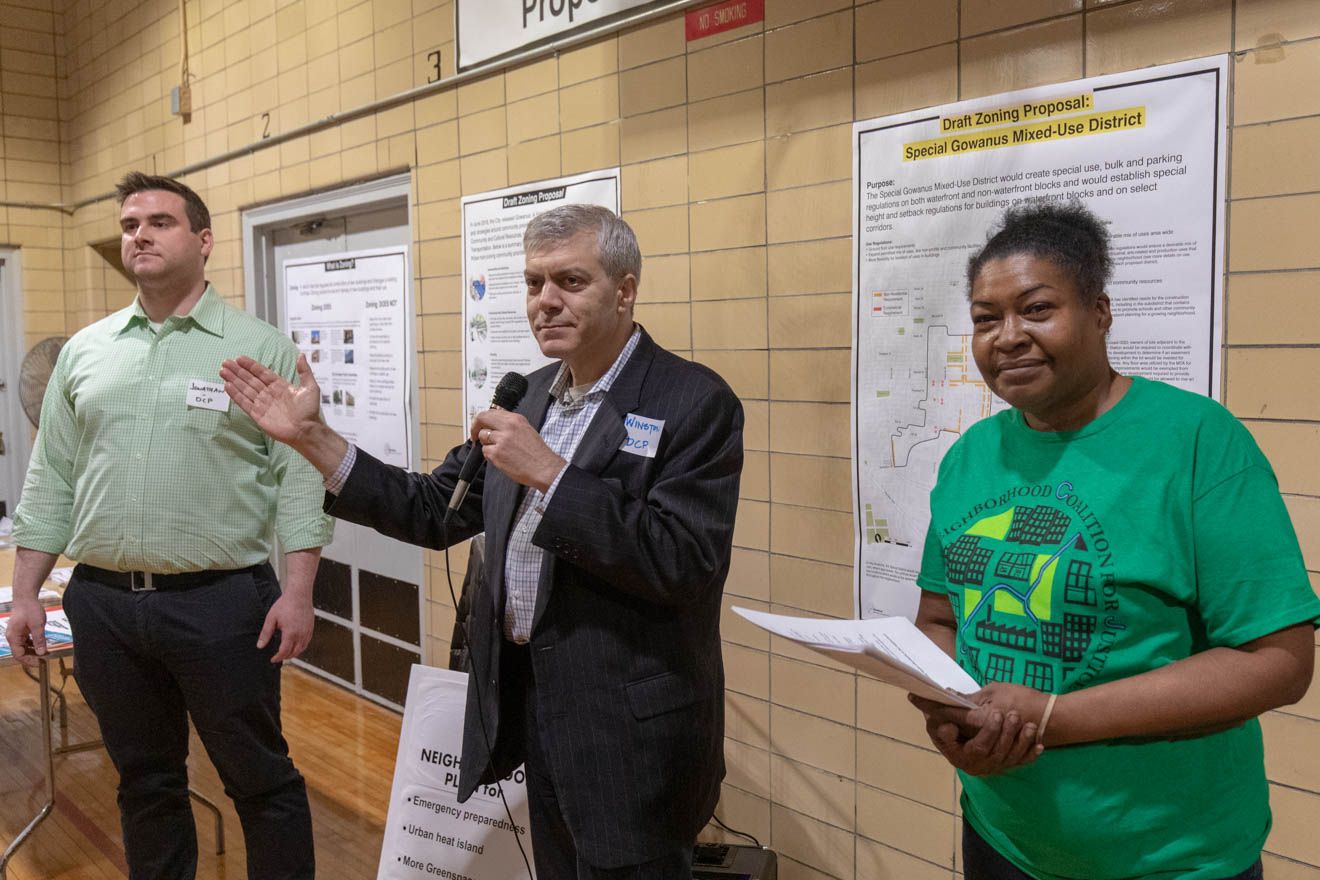
“How does the draft DCP plan preserve and protect public housing?” was Blondel’s first question for the pair.
“We want to stress that public housing is part of the Gowanus Neighborhood Plan,” Von Engel responded. “It is part of the study area, you’re part of our community, you’re part of this planning process. In that sense, NYCHA is very much part and parcel of this community.”
Next, Blondel asked, “Is the city committed to providing the necessary subsidies to provide 100% affordability on city-owned sites, specifically the Gowanus Green and Public Place site?” Keller responded by reminding her of the November workshop which discussed 100% affordability at Public Place as well as commercial, open, and park space.”We’re working with the development team and HPD to make that happen,” he assured her.
“And you Karen, and the rest of the Coalition, were part of that workshop,” Von Engel noted, to which Blondel replied, “We were definitely a part of the workshop. We went to dozens of workshops but we still feel like our commitments are not here in writing.”
“We demand from public housing—fix our homes before you rezone. We’ve said this for the last two years,” Blondel said. “When the Mayor talks about preserving and creating affordable housing—there is no housing that is more affordable in this city other than public housing. Public housing and affordable housing are two types of housing, they are not the same.”

Among GNCJ’s other demands are “a commitment of 100% affordability on all publicly-owned sites in Gowanus. 100% affordability for the people who already live here,” said Blondel, as well as “the deepest affordability options for MIH (Mandatory Inclusionary Housing).” The Coalition is also calling for new financial commitments for NYCHA. “We haven’t heard one funding commitment in this rezoning framework. Where’s the money for this community?” she asked.
“We are a part of this community,” Blondel noted. “We’ve been in this community for 30, 40, 50 years. We’ve been through urban renewal, blight, we’ve been through everything, and we held on. And now that we’re aging, you’re trying to put us out of the community, and not just by ignoring the fact that we need infrastructure work and repairs, but you’re taking away our grocery stores, you’re taking away the things that we like to do, and where we want to go.”
A member of the audience added “none of the stuff that’s in this plan is what people actually wanted. People wanted more schools, NYCHA housing fixed, the sewage problems fixed, better transportation, park land. High-rise luxury housing is not what people were looking for,” he said.
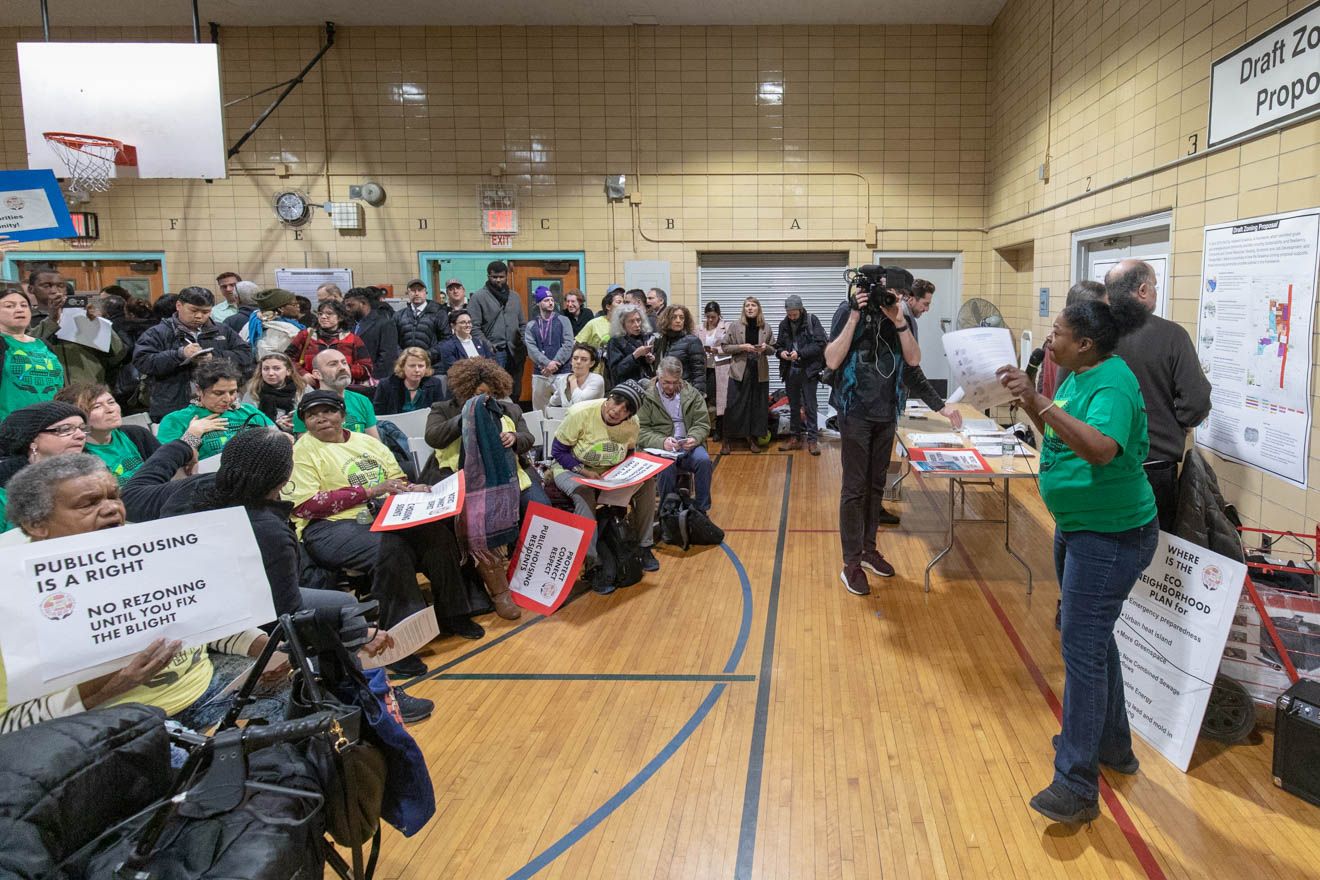
“We spent two and a half years discussing, working with the groups, spending a lot of time getting to know everybody in the planning department. I would like to know why this is the format today?” asked another audience member. “It should be a presentation. The least [DCP] could have is a presentation of the draft that we participated in [creating]. I don’t see a lot of the things that we requested in this draft,” she added.
Keller noted that DCP will present the Gowanus Draft Rezoning Proposal to Community Board 6 at the next Land Use committee meeting scheduled for Thursday, February 28 at 6pm. (Location to be determined.)
“To reiterate what we’re saying, we spent two and a half years going to work groups,” Blondel noted. “The way this format is set up, I don’t actually see anything that we specifically talked about in these plans the way you set [it] up. I’m not saying they’re not there…. We want a PowerPoint presentation where somebody is going slide by slide, showing us block by block…” [cheers of approval drowned out the rest of her statement].
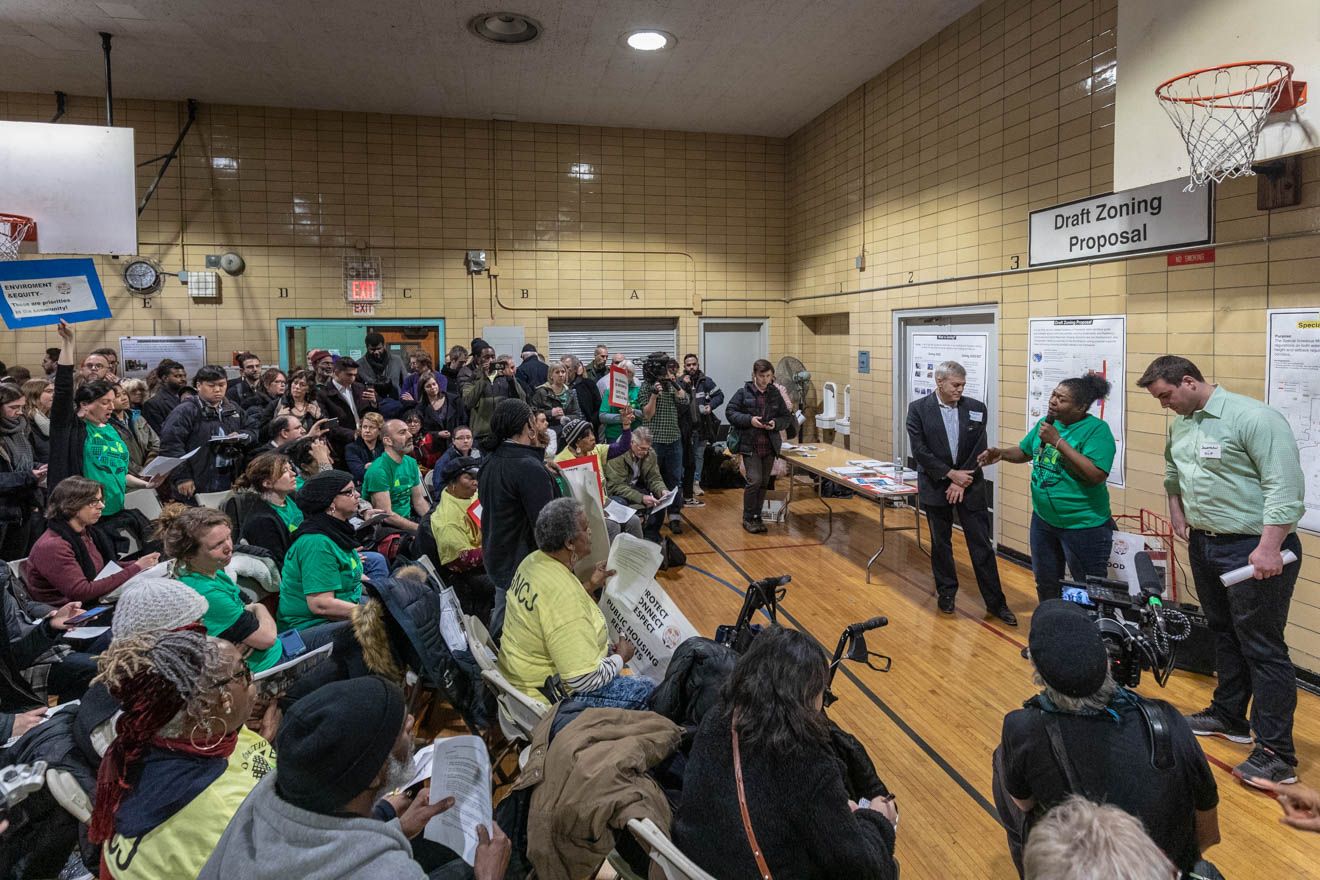
Several others in the crowd inquired about the eco-district that had been discussed over the years. “Where’s the eco-neighborhood?” they wanted to know. “In all of our discussions about that goal of making it into a green eco-neighborhood, that is baked into everything we are doing. If you don’t see the words ‘eco-neighborhood plan,’ that’s just because we don’t brand things in that way,” Keller answered. “Everything in what we are doing and proposing is to make Gowanus a greener, healthier, resilient, sustainable neighborhood, and a mixed-use neighborhood too.”
Keller’s response was not satisfactory for some, inciting cries of: “Where’s the emergency preparedness?” “Where’s the urban heat island mitigation?” “Where’s the green space?” “Where’s the CSO capture?” “Where’s the renewable energy?” “Answer something!”
The Proposal covers an area (see map) bounded by Bond Street and 4th Avenue (west to east) and Baltic Street to Huntington, 3rd, 7th and 15th Streets (north to south), the zoning proposal addresses sustainability and resiliency; housing; economic and job development; community and cultural resources; waterfront and open space; and building density.
Key aspects of the Draft Zoning Proposal include:Canal Corridor
- Creating a Waterfront Access Plan (WAP) that will include an esplanade, parks, bridges, and new mixed-use buildings (featuring permanently affordable housing, commercial space and art space) along the Gowanus Canal
- Elevating the shoreline to help prevent flooding
- Including a new resilient public park at the City-owned Public Place (at Smith and 5th Street, adjacent to the Gowanus Canal)
- Allowing new mixed-use buildings along the Canal that can rise (after setbacks) to 22 stories and even 30 stories at Block 471—a privately-owned property south of Public Place
“The Canal is very much alive…way more alive than people realize,” Gary Francis, a member of the Gowanus Dredgers, said after the meeting. “It’s got a bad name. It’s the body of water that people love to hate.” He noted that as the EPA works to cleanup the Gowanus Canal, the draft rezoning proposal is only “making it more inaccessible.”
“There still isn’t any real water access. The water access that is labeled and talked about on the posters…really means water views,” Francis added.
“They’re talking about elevating the land, so the bulkheads that are already very high above the waterline are going to be even higher and if there are no ladders and no docks or any other means for someone who’s fallen in the water to get out, that’s a problem,” fellow Dredger, Brad Vogel, added.
“And for recreational boaters it’s difficult to use the canal. That’s my overarching concern with the plan is that it treats the canal like a giant sculpture to be viewed but not engaged with,” Vogel continued. “We see the waterway, even in its current state, as something we can interact with as a real waterway. We really do need to be planning for the cleaned up Canal and making sure that the infrastructure around the edges of the waterway permits people to engage with it.”
“I do think there’s actually a lot of really good stuff about the waterfront access,” said Andrea Parker, Executive Director of the Gowanus Canal Conservancy, which is also part of GNCJ. “The Waterfront Access Plan is going to be a really critical tool to making sure that the public space that developers are required to build along the waterfront is accessible, is eco-logically productive, and resilient. There’s promotion of soft edges, promotion of programming. We really want to have a waterfront that serves the larger community and that everyone can get to and feel part of.”
Industrial and Commercial
- Increasing density for industrial, commercial, and cultural spaces for these areas: new buildings between 3rd and 4th Avenues from Butler to Sackett Streets would be permitted to rise up to 12 stories; while other industrial/commercial areas, including 3rd Street to 7th Street between 3rd and 4th Avenues would be allowed to build up to 8 stories
- Eliminating parking and loading requirements for small businesses
- Continuing to prohibit residential development in these areas
- Promoting new job-generating uses including industrial, arts and cultural uses
“We care about each other here,” said Blondel. “We’re not just here for public housing residents. We’re here to discuss the IBZ zone, because that relates to the public housing residents and the other residents working close to home. We’re worried about our arts and culture over here. This area is abundant with artists and people who are creative, they might actually come up with a cure for the CSO or for the carbon emissions, but if we shut them out, they won’t have a place to be innovative.”
Enhanced Mixed Use
- Allowing medium- to high-density housing along major corridors
- Requiring all new developments to include permanently affordable housing (including on 4th Avenue, which was previously rezoned)
- Reinforcing a live-work neighborhood by balancing and preserving neighborhood scale and encouraging growth that promotes a mix of uses
- Remediation of brownfield sites to safely accommodate new development
- Rezoning streets surrounding Thomas Green Playground (Douglass, 3rd Avenue, and Degraw) for M1(4)/R7X which would allow new mixed-use developments to rise up to 14 stories
- Allowing mixed-use buildings on 4th Avenue (from Pacific to 15th Street) to rise up to 17 stories
“My main concern is the sewage, there are no new tools or commitments to addressing the new sewage that’s going to be produced by the additional density,” said Parker. “It’s not DCP’s role to do this, it’s really DEP’s and the Mayor’s to take this seriously and address this. In the plan they list a bunch of sewage and storm water infrastructure that the city’s already required to build under the Superfund and the Clean Water Act. That is going to help with the existing problem, but it’s not going to help with the future development.”
Council Member Brad Lander also came forward and joined GNCJ’s meeting, acknowledging that the draft rezoning proposal does not currently do enough to address the issues of public housing developments in Gowanus. “We aren’t going to have a satisfactory plan until we get to a place where there is more investment in public housing,” he told the crowd. “We also know that some of the neighbors in the industrial business zone have a lot of issues that they need attended to and that we’ve got work to do there,” he added.

“I encourage you to take a look [at the proposal details] because there actually is some really interesting stuff about schools…” as well as transit, resiliency and sustainability, and open space, the Council Member insisted. “I am pretty sure if they gave a prize for a neighborhood that did the most planning about how to think about its future, definitely in NYC or maybe in the whole world, I’m pretty sure it would be Gowanus,” he added. Council Member Stephen Levin did not attend the open house.
When asked after the meeting if he felt the draft zoning proposal addressed NYCHA enough, Keller told Bklyner, “Not yet, but we’re not there.” He noted that early on during the working group meetings, the community expressed the need to reopen the Gowanus Community Center. “We agreed with them, we said we’d work on it,” he said. “The Mayor committed to opening [it] up in 2017 and the update is now that there’s funding allocated for it and that the stakeholders will be engaged before the renovations begin.”
“As you know, lots of things are going on with NYCHA, so identifying what those improvements are now, how much money is needed, all that may change over a matter of six months,” Keller added. “It’s still a commitment we stand by but it’s not something we can put numbers behind or identify things right now because we’re not at that point in the process.”
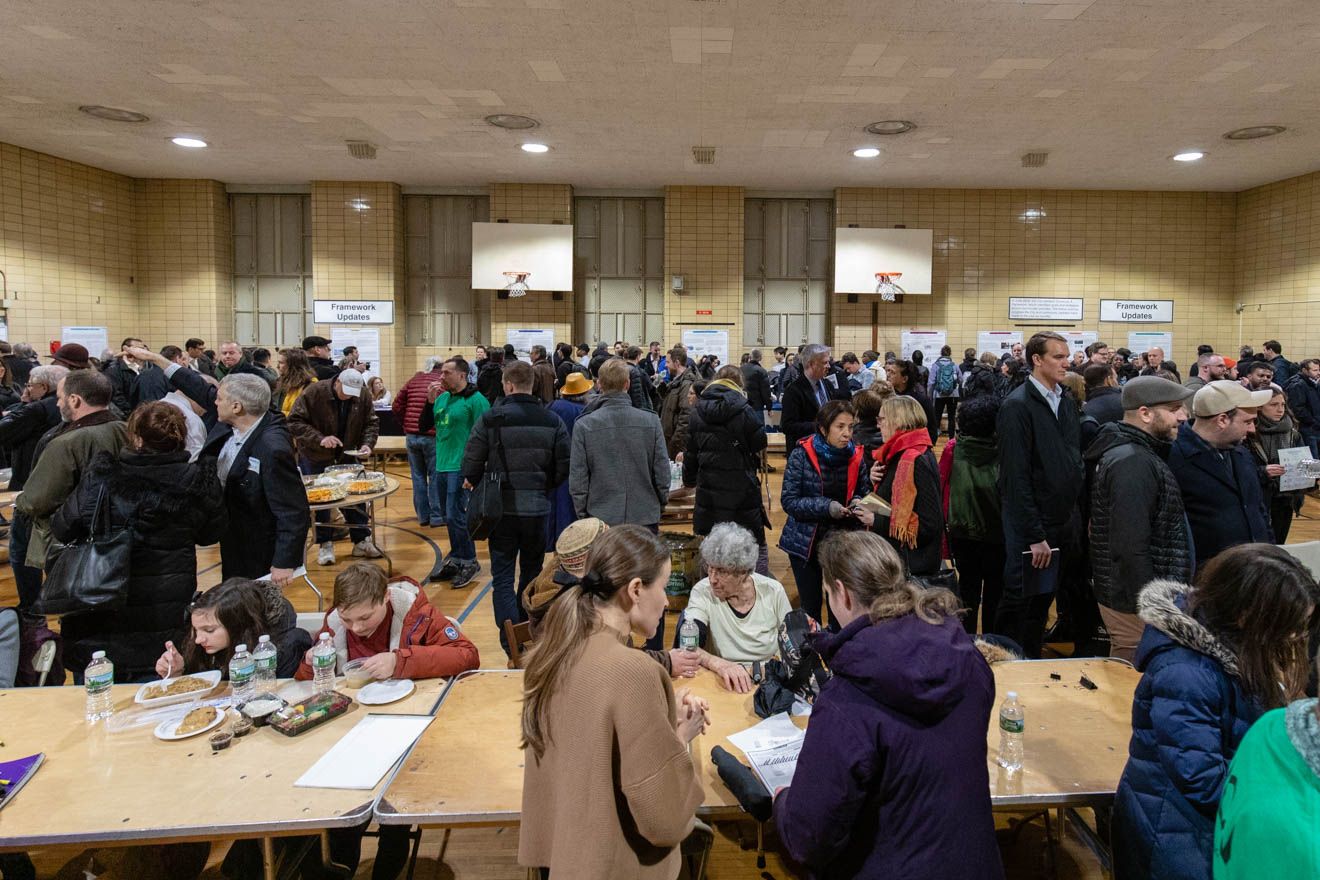
Regarding the complaints about the open house format of Wednesday’s meeting, Keller noted that when the Framework was released last June, DCP presented it to the community board first, then held an open house a few weeks later. He said some were not happy with that process either, saying some community members didn’t feel they had enough time to “digest” the information. “There is so much here. We’ve actually responded to an enormous amount of what people want to see, and from all the feedback we’ve heard we felt just giving a presentation would be so overwhelming that we wanted to allow weeks to go by so people could really formulate their thoughts and questions and then come ready to learn more,” he said, promising a detailed PowerPoint presentation at the February 28 community board meeting.
Though last night’s meeting became heated at moments, Keller remained optimistic. “It was a really good turn-out. I had a lot of good conversations,” he said. “I think it was actually very positive and a really good showing of democracy and that folks are really engaged in this community.”
When asked if she felt her concerns were addressed last night, Blondel said, “Not really, but I think that they’re on notice now that we’re not going to back down,” then she sang, “We won’t back down, no we won’t back down!”




